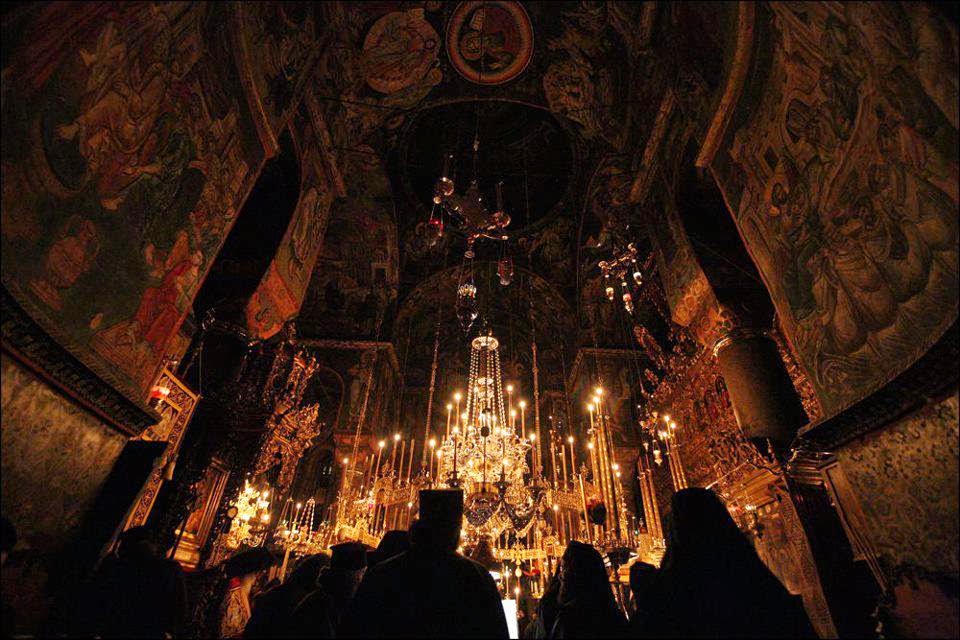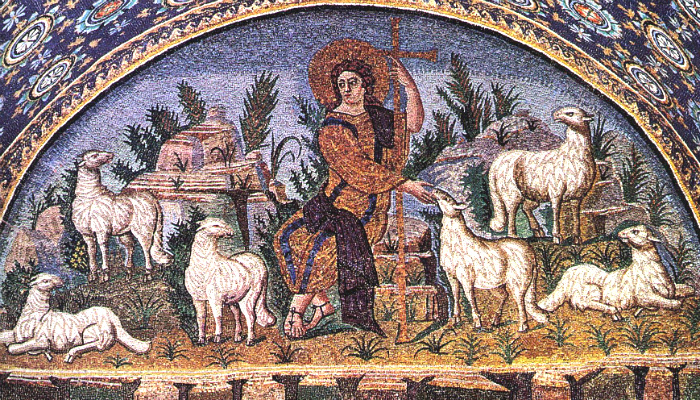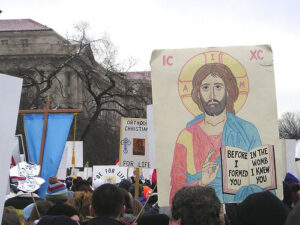
Beauty so ancient and so new
From time to time my friends and I get into a discussion about Christian unity. Anglicans and Roman Catholics seem to be especially eager to reunite with the Orthodox and I have to explain why such efforts are difficult, if not improbable. This position is often met with frustration and perplexity: Why can’t we just be one? What’s the hang up? I began to notice that we seem to be speaking past each other. As I reflected on this impasse I realized that we were operating from different paradigms. One is what I call the recognition paradigm and the other, the reception paradigm.
The recognition paradigm involves the mutual recognition of the validity of the other church’s baptism, their clergy’s ordination, their doctrines, and allowing for inter-communion among their members. The reception paradigm involves one church body accepting the other church’s doctrines and practices as normative, and being received or incorporated into the other church body. Understanding the difference in paradigms can go a long way in helping Christians understand each other.
Invisible or Visible Church?
The question of church unity depends on how we understand the Church. When I was a Protestant Evangelical I was taught that there was the visible local congregation and the invisible universal capital “C” church which consists of all true “born again” Christians. Thus, the ideal Church existed in heaven above all the scandalous divisions among Christians here below.
But when I reflected on the Apostle Paul’s teachings in I Corinthians 12 about the body of Christ I began to see a contradiction between what Paul taught and what modern Evangelicals believed. An invisible body is essentially a ghost, not a genuine body. This notion of an invisible body of Christ also ran contrary to I John 1:1-3 which taught that Jesus’ tangible and visible body was the core of the Gospel. This led me to question whether Evangelicalism’s invisible capital “C” church was theologically sound.
I began to move towards the idea of a visible Church as I started reading about the early Church. I was haunted by Irenaeus of Lyons’ description of the early Church:
Having received this preaching and this faith, as I have said, the Church, although scattered in the whole world, carefully preserves it, as if living in one house. She believes these things [everywhere] alike, as if she had but one heart and one soul, and preaches them harmoniously, teaches them, and hands them down, as if she had but one mouth. (Against Heresies 1.10.2; emphasis added)
The early Church shared the same faith and worship all across the Roman Empire. This was so different from Protestantism’s many denominations. The early Church was remarkably free of denominationalism, why wasn’t the same true of Protestantism?
I was also struck by the early Christians’ emphasis on the importance of belonging to the visible Church. Cyprian of Carthage wrote:
He can no longer have God for his Father, who has not the Church for his mother. (On the Unity of the Church §6)
My view changed further as I reflected on the Nicene Creed’s line: “I believe in one, holy, catholic and apostolic Church.” The word “one” means that there is only one Church, not two churches, nor two halves. Nor does it mean the branch theory Anglicanism proposes or the multitude of denominations as is the case with Protestantism. The problem with the Anglican branch theory is that it substitutes the church catholic with the church comprehensive. Anglican comprehensiveness superimposes liturgical uniformity on doctrinal pluralism. Because there is no precedent for this in the early Church, this approach is highly suspect. Likewise, I began to see that if one took the idea of the visible Church seriously then Protestant denominationalism is like Humpty Dumpty all broken up in pieces waiting for someone to make him whole again.
In Orthodoxy I encountered a different paradigm: the Orthodox Church IS the one holy, catholic, and apostolic Church confessed in the Nicene Creed. Kallistos Ware in The Orthodox Church wrote:
The Orthodox Church in all humility believes itself to be the ‘one, holy, Catholic and Apostolic Church’, of which the Creed speaks: such is the fundamental conviction which guides Orthodox in their relations with other Christians. There are divisions among Christians, but the Church itself is not divided nor can it ever be. (p. 307)
For Orthodoxy there has always been one Church. There may have been people and groups that fell into heresy and schism: they have left the Church but the Church always retained her unity. A leaf may fall from a tree or a branch may break off, but there still remains one tree. Theologically speaking, it is heretical to believe that where there was one Church there is now two or more churches, or that the one Church is now broken into several fragments, or that one Church is now invisible. For Orthodoxy the one Church has never been lost. It has never gone away because it is here in the Orthodox Church.
Many Western Christians are offended by the Orthodox position. They interpret this to mean that Orthodoxy is superior to other religious traditions, or that God’s grace is found only in Orthodoxy and absent outside. The irony of the Orthodox understanding of visible church unity is that it has been regarded as schismatic, especially by Protestants! This can be seen for example in Gordon-Conwell adjunct professor Preston Graham Jr.’s paper on ecumenicism. Of the Orthodox understanding he noted:
This option seeks to express visible unit by limiting the church to what is in reality only one denomination or “tradition” based on one interpretation of the meaning of apostolic order/succession such as to exclude all dissenting views of apostolic order/succession. The sum effect of this option is to seek after visible unity by means of schism! (p. 26)
Protestant Egalitarianism
Prof. Graham’s rejection of Orthodox ecclesiology is rooted in Protestantism’s almost dogmatic insistence upon egalitarianism. There is a certain appeal to Protestantism’s ecclesial egalitarianism; all churches are equal therefore Orthodoxy is just one denomination among many. This insistence on the equality of all church bodies likely stems from the Reformers’ rejection of the Roman papacy. It also conforms to the modern mindset which favors individual liberty and equality for all. If all men have an inherent right to an equal liberty, who’s to say that one Church structure and Tradition should be favored over any other?
Protestant ecclesial egalitarianism can also be found in the Anglican branch theory. An interesting take on the branch theory is the stance that no one branch is the true Church therefore we all need each other. There is a certain humility in this stance but it also opens the door to theological relativism. It is a sad fact that Anglicanism today is theologically incoherent and increasingly fractured.
In addition to Protestant ecclesial egalitarianism, there is corollary epistemological egalitarianism. This takes the form of all Christians being equal with respect to the interpretation of Scripture. This is a consequence of the Reformers’ rejection of the papacy. In light of the supremacy of Scripture (sola scriptura), they feel free to reject or disregard what they call “manmade doctrine.” More recently, Protestant egalitarianism took a postmodern turn with the Emerging Church movement criticizing the traditional church’s “captivity to Enlightenment rationalism.” (see O’Brien 2009) The Protestant disbelief in a supernatural capital “T” Tradition makes discussion of reunion highly problematic. Here we see two disparate paradigms for the source of doctrine. For Protestants it is Scripture Alone; the church plays an auxiliary role but not a determinative role in the making of doctrine. The belief that there is no capital “T” Tradition, only manmade traditions, implies a disbelief in Christ’s promise that he would send the Holy Spirit to guide the Church (John 16:13).
But for Orthodoxy, the Church is the recipient and guardian of Apostolic Tradition. Under the guidance of the Holy Spirit she preserves and expounds Scripture for the generations to come (John 14:26, Ephesians 4:11). Theological controversy is best settled through the conciliar method. The Jerusalem Council in Acts 15 provided the precedent for the Ecumenical Councils. Just as the Jerusalem Council was guided by the Holy Spirit, so also the Ecumenical Councils.
Some of my Anglican friends are appreciative of small “t” tradition, but they view certain Orthodox positions, e.g., Mary as the Theotokos or the veneration of icons, as too extreme. They see themselves as a moderating center between Orthodoxy and low church Evangelicalism. But I noticed that like their low church brethren, Anglican Evangelicals reject all supernatural notion of Apostolic Tradition. The presupposition of sola scriptura held by Protestants, whether low church or high church, constitutes a major obstacle to church reunion. If Anglicans desire reunion with Orthodoxy they need to be willing to renounce sola scriptura and embrace the very same Holy Tradition passed on by the Apostles.
Scripture Alone does not exclude other sources like ancient church councils and church fathers. Evangelicals seeking to engage Orthodoxy are often enthusiastic practitioners of ressourcement. They appropriate from the early Church while blithely ignoring its authority. This cherry picking approach is fundamentally flawed. Augustine of Hippo summed up the matter aptly when he wrote:
If you believe what you like in the Gospels, and reject what you don’t like, it is not the Gospel you believe but yourself.
Some Evangelical pastors love to pepper their sermons with quotations from early church fathers but they do this selectively. Few Protestants have come to grips with the fact that while they embrace certain church fathers as individuals, they ignore the fathers’ Church. For example, Augustine wrote:
For my part, I should not believe the gospel except as moved by the authority of the Catholic Church. (Against the Fundamental Epistle of the Manichees, Chapter 5)
Here Augustine was warning against an individualistic Christianity divorced from the visible Church. This is something that Ancient-Future Evangelicals are reluctant to grapple with. So my question to Protestants seeking church unity is: Are you willing to put sola scriptura on the table? In a Facebook thread I described what this approach would entail:
If you really want to put sola scriptura on the table consider whether you would be willing to accept the Council of Nicea’s Creed as authoritative, binding on all Christians, and an infallible guide for understanding what Scripture teaches. For me this conciliar hermeneutics provides the basis for theological unity. A departure from conciliar hermeneutics will result in doctrinal pluralism and relativism. Accepting this position wouldn’t necessarily make you Orthodox but it would provide for a common basis for discussion with Orthodox Christians.
It is good to see Evangelicals develop an interest in the church fathers and the early liturgies. I would also encourage them to learn from the way the early church fathers read Scripture and to see how the conciliar hermeneutics differ from later Protestant hermeneutics. A patristically informed biblical hermeneutics can help build bridges between Evangelicals and Orthodox. (See Scot McKnight’s posting “Patristics and the Bible.”)
Horizontal and Vertical Unity
There are two critical dimensions to church unity. Horizontal church unity consists of unity among churches across space; vertical church unity consists of unity across time – being united with the ancient churches founded by the Apostles. Key to vertical unity is apostolic succession through the office of the bishop. It is through the local bishop that the local Orthodox parish is linked to the early Church. Reading the writings of the early church fathers or using early liturgical texts do not suffice for vertical unity. The office of the bishop is one key difference between Protestant and Orthodox approaches to unity.
For Orthodoxy horizontal and vertical unity are both critically important. They are found in the Eucharist and in the bishop who presides over the Eucharist. Receiving Communion in Orthodoxy means sharing the same faith as other Orthodox Christians around the world today. And through its bishop the local Orthodox parish can trace a direct historical link to the “breaking of bread” mentioned in Acts 2:46!
Christians interested in church unity need to understand Orthodoxy’s distinctive understanding of Tradition. Apostolic Tradition is key to understanding Orthodox ecclesiology. Bishop Kallistos Ware recounted Father Lev Gillet’s definition of Orthodoxy:
An Orthodox is one who accepts the Apostolic Tradition and who lives in communion with the bishops who are the appointed teachers of this Tradition. (The Inner Kingdom p. 14; italics in original)
The key here is the crucial role played by the bishop in Apostolic Tradition. At the time an Anglican, Ware found this to be an eye opener. He recounted:
Orthodoxy, so I recognized in a sudden flash of insight, is not merely a matter of personal belief; it also presupposes outward and visible communion in the sacraments with the bishops who are the divinely-commissioned witnesses to the truth (The Inner Kingdom p. 15; emphasis added).
So with respect to Orthodoxy’s claim to be the true Church, the question is not superiority versus inferiority, but rather fidelity to and continuity with Apostolic Tradition.
In the early Church the bishop was more than an administrator, as the successor to the Apostles he presided over the Eucharist and guarded the doctrinal purity of the Church. This understanding of the crucial role of the episcopacy to the integrity and unity of the Church is an ancient one. Irenaeus of Lyons wrote:
This is true Gnosis: the teaching of the apostles, and the ancient institution of the church, spread throughout the entire world, and the distinctive mark of the body of Christ in accordance with the succession of bishops, to whom the apostles entrusted each local church, and the unfeigned preservation, coming down to us, of the scriptures, with a complete collection allowing for neither addition nor subtraction, a reading without falsification and, in conformity with the scriptures, so interpretation that is legitimate, careful, without danger of blasphemy. (Against Heresies 4.33.8; emphasis added)
Augustine had a similar high view of the episcopacy. He wrote:
The consent of peoples and nations keeps me in the Church; so does her authority, inaugurated by miracles, nourished by hope, enlarged by love, established by age. The succession of priests keeps me, beginning from the very seat of the Apostle Peter, to whom the Lord, after His resurrection, gave it in charge to feed His sheep, down to the present episcopate. (Against the Fundamental Epistle of the Manichees, Chapter 5; emphasis added)
Many Protestant churches do not have bishops or if they do have bishops are unable to trace an unbroken lineage back to the Apostles. The concept of apostolic succession is alien to Protestant theology. Much of the efforts at church unity by Protestants have been focused on horizontal unity with little attention given to vertical unity. This is the greatest flaw in the mutual recognition approach to church unity. In its pursuit of horizontal unity it has sacrificed vertical unity.
A local Orthodox parish cannot modify its liturgy or doctrine unilaterally. If a local Orthodox parish were to do so in order to have unity with their Protestant neighbors they will have severed their connections with the Orthodox Church worldwide not to mention their ties with the early Church. Moreover, no Orthodox bishop would permit a local parish to stray from Apostolic Tradition. The bishop’s job is to preserve the unity and integrity of the Church.
There are two types of church bodies: those whose episcopacy can claim linkage to the original Apostles (Orthodoxy, Roman Catholicism, and the Non-Chalcedonian churches) and those whose leadership cannot make that claim (Protestantism). Recognition to one degree or another is possible with these church bodies that can claim historic ties to the early Church (see Ware The Orthodox Church pp. 311-316). But in the case of Protestants who have broken off from the papacy recognition is ruled out as an option. This means that union with the Orthodox Church is through reception.
Western Ecumenicism
It seems that for Western Christianity church unity is a problem that needs to be solved, that church unity has been lost and needs to be restored. There seems to be a certain eagerness and anxiety in the West’s endeavors to achieve unity with Orthodoxy. When it comes to unity among Christians two important issues need to be addressed: (1) the nature of the unity we seek and (2) and the path we are to take to get there.
For example, my Anglican friends insist that they are part of the “catholic church” confessed in the Apostles Creed and the Nicene Creed. They note that they use the “same” Nicene Creed as the Orthodox and that they too can claim apostolic succession. In the course of numerous discussions I began to realize that while my Anglican friends don’t hold to Orthodox doctrine or follow Orthodox practices, what they want is for Orthodoxy to recognize the validity of their Anglican doctrines, rites, and clergy. In other words, they are seeking mutual recognition between Anglicans and Orthodox even with the disparity in doctrine, worship, and polity.
Mutual recognition is also the strategy that Roman Catholics are using with Orthodoxy. Pope John Paul II adopted the branch theory when he spoke of Roman Catholicism and Orthodoxy as two lungs breathing together. They are not asking any changes in Orthodox doctrine and practice; “all” they are asking for is for Orthodoxy to come under the authority of the Bishop of Rome which for Orthodoxy is a deal breaker.
Related to the mutual recognition paradigm is interfaith dialogue. Many in the ecumenical movement approach interfaith dialogue much in the spirit of labor versus management negotiations: We will give a little on this, if you give a little on that. They believe that doctrine, worship, and polity are all “on the table.” Another ecumenical tactic is to redefine or reframe theological issues so that both sides, once at odds with each other, can now sign a joint statement. Orthodox priest Georges Florovsky called this “doctrinal minimalism.” This approach to ecumenicism is based on an ecclesial pragmatism and theological relativism, or a theological reductionism that seeks to frame doctrine in broadest possible terms.
But for Orthodoxy Holy Tradition is the fullness of the Faith and therefore not negotiable. The Church is not a social construct but a divine creation founded by Christ himself (Matthew 16:18). Thus, one of the major impediments to ecumenical dialogue is that we differ significantly on the goal (the kind of unity we seek) and the means (the path to unity).
Christian Collaboration in a Pluralistic Society
There are two kinds of goals for Christian unity. One goal is Christian unity in the form of one family. The family model of Christian unity is based on the assumption that we are all related to one another and that we live under the same roof. Given the Orthodox understanding of church unity, union with Protestants through the recognition paradigm is unfeasible. The only viable path to unity is through reception.
But what if Protestants are not ready to give up their core Protestant beliefs, what then? I suggest that there is an alternative approach to Christian unity available to Orthodox and non-Orthodox. That is Christian unity in the form of being friendly neighbors. We live next door to each other but we live under separate roofs. We coexist peacefully and work cooperatively on important projects in the name of Christ.
We need to encourage and support friendly cooperative relations across the Christian traditions. We can respect each others’ different traditions as we seek to work together for a Christian witness in a pluralistic, post-Christian American society. The annual March for Life in which Protestants, Roman Catholics, and Orthodox come together is a good example interfaith cooperation.
In Hawaii I am happy to be part of a monthly get together of “mere Christians” comprised of Protestants, Anglicans, Roman Catholics, and Orthodox Christians. We come together in Christ’s love from our different church traditions for a common meal and a talk on faith and culture.
Unity through Coming Home
What is the reception method like? In the 1970s a group of Evangelicals became interested in the early Church. They discovered to their great surprise that early Christian worship was liturgical and sacramental so they became liturgical and sacramental in their worship. They found out that the early Church was creedal so they adopted the Nicene Creed. Along the way they found out the early Church had priests and bishops, so they ordained each other as priests and appointed their own bishops! They even went so far as to make altars and put up tiny postcard size icons behind their altars. They thought of themselves as “orthodox” until they came face to face with Eastern Orthodoxy. Peter Gillquist tells the story how this group of Evangelicals was received into the Antiochian Orthodox Church in his book Becoming Orthodox. But in terms of numbers this paled in comparison with the reception of some twenty thousand Uniates into Orthodoxy in the late 1800s.
There is a great hunger among Protestants today for the early Church and for church unity. This has led to many rediscovering the early church fathers and seeking to bring back liturgical worship. This hunger for ancient Christianity manifested itself in the 1800s in the Mercersburg Theology in the US and in the Oxford movement in England, and more recently in the Federal Vision movement and the Ancient-Future worship movement. This recent enthusiasm for church unity and the ancient faith is very commendable but carries a high price tag. If one wishes to enter into Eucharistic unity with the ancient Church one must be prepared to give up aspects of Protestantism that are at odds with the ancient Christian Faith. Reception should not be viewed as an obstacle but an open door. Thousands of Protestants have already taken this bold step and hopefully many more in the days to come will unite themselves with the one Church confessed in the Nicene Creed.
Robert Arakaki
Other articles:
Former Church of England priest Michael Harper‘s conversion story
“A Calvinist Anglican Converts to Orthodoxy” Interview: Joseph Gleason with Mark Bradshaw — Journey to Orthodoxy (24 October 2013)
“Episcopal congregation embracing Orthodox faith” by Carla Hinton NewsOK (7 July 2007)
“St. Alexis Toth – Confessor of the Orthodox Faith in America”
Service Text: “Service for the Reception of Converts” (denver.goarch.org)










Recent Comments